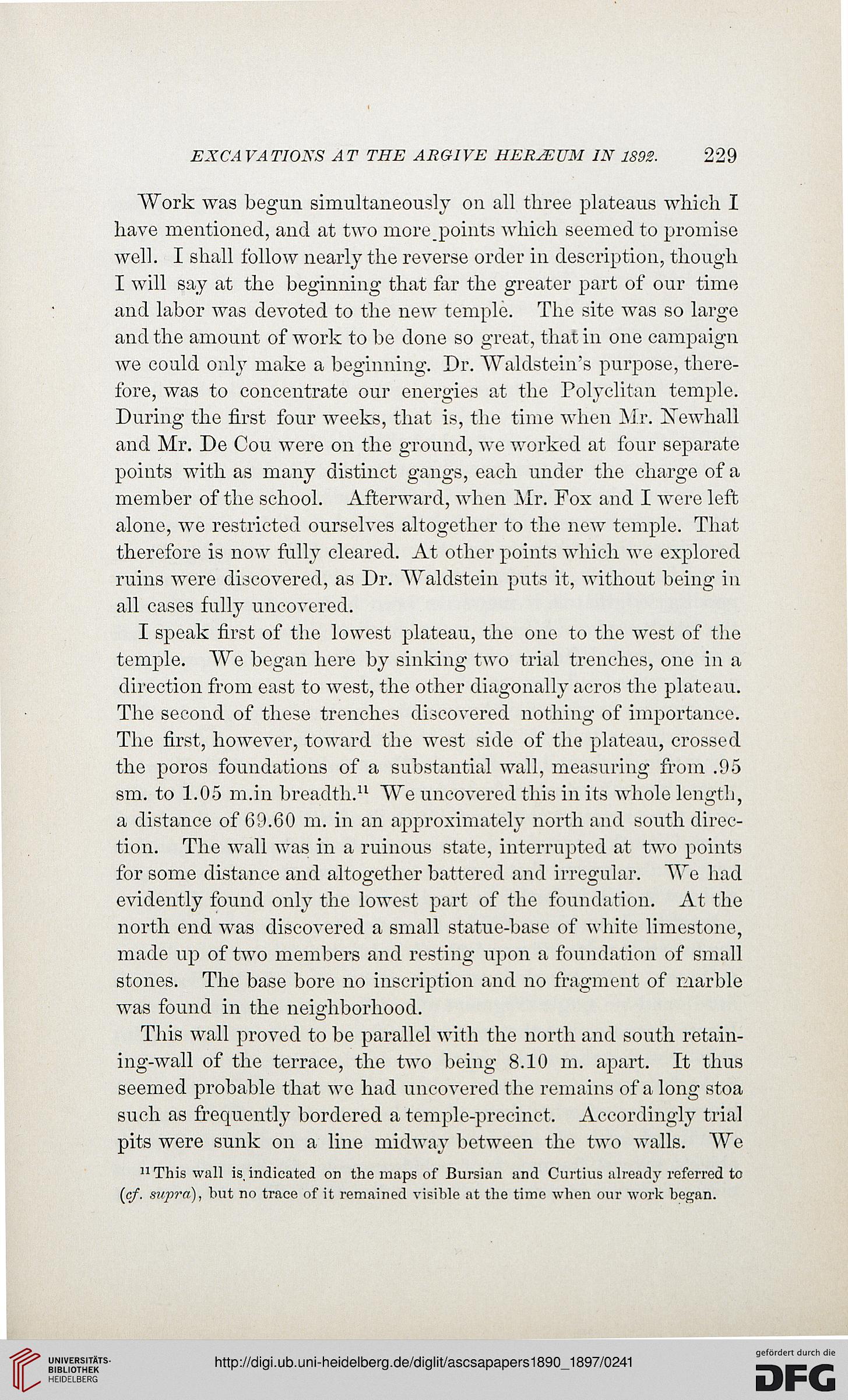EXCAVATIONS AT THE A R GIVE HERJEUM IN 1892. 229
AVork was begun simultaneous]}7 on all three plateaus which I
have mentioned, and at two more points which seemed to promise
well. I shall follow nearly the reverse order in description, though
I will say at the beginning that far the greater part of our time
and labor was devoted to the new temple. The site was so large
and the amount of work to be done so great, that in one campaign
we could only make a beginning. Dr. AValdstein's purpose, there-
fore, was to concentrate our energies at the Polyclitan temple.
During the first four weeks, that is, the time when Mr. Newhall
and Mr. De Cou were on the ground, we worked at four separate
points with as many distinct gangs, each under the charge of a
member of the school. Afterward, when Mr. Fox and I were left
alone, we restricted ourselves altogether to the new temple. That
therefore is now fully cleared. At other points which we explored
ruins were discovered, as Dr. "Waldstein puts it, without being in
all cases fully uncovered.
I speak first of the lowest plateau, the one to the west of the
temple. We began here by sinking two trial trenches, one in a
direction from east to west, the other diagonally acros the plateau.
The second of these trenches discovered nothing of importance.
The first, however, toward the west side of the plateau, crossed
the poros foundations of a substantial wall, measuring from .95
sm. to 1.05 m.in breadth.11 We uncovered this in its whole length,
a distance of 69.60 m. in an approximately north and south direc-
tion. The wall was in a ruinous state, interrupted at two points
for some distance and altogether battered and irregular. We had
evidently found only the lowest part of the foundation. At the
north end was discovered a small statue-base of white limestone,
made up of two members and resting upon a foundation of small
stones. The base bore no inscription and no fragment of marble
was found in the neighborhood.
This wall proved to be parallel with the north and south retain-
ing-wall of the terrace, the two being 8.10 m. apart. It thus
seemed probable that we had uncovered the remains of a long stoa
such as frequently bordered a temple-precinct. Accordingly trial
pits were sunk on a line midway between the two walls. We
II This wall is, indicated on the maps of Bursian and Curtius alread}'referred to
[cf. supra), but no trace of it remained visible at the time when our work began.
AVork was begun simultaneous]}7 on all three plateaus which I
have mentioned, and at two more points which seemed to promise
well. I shall follow nearly the reverse order in description, though
I will say at the beginning that far the greater part of our time
and labor was devoted to the new temple. The site was so large
and the amount of work to be done so great, that in one campaign
we could only make a beginning. Dr. AValdstein's purpose, there-
fore, was to concentrate our energies at the Polyclitan temple.
During the first four weeks, that is, the time when Mr. Newhall
and Mr. De Cou were on the ground, we worked at four separate
points with as many distinct gangs, each under the charge of a
member of the school. Afterward, when Mr. Fox and I were left
alone, we restricted ourselves altogether to the new temple. That
therefore is now fully cleared. At other points which we explored
ruins were discovered, as Dr. "Waldstein puts it, without being in
all cases fully uncovered.
I speak first of the lowest plateau, the one to the west of the
temple. We began here by sinking two trial trenches, one in a
direction from east to west, the other diagonally acros the plateau.
The second of these trenches discovered nothing of importance.
The first, however, toward the west side of the plateau, crossed
the poros foundations of a substantial wall, measuring from .95
sm. to 1.05 m.in breadth.11 We uncovered this in its whole length,
a distance of 69.60 m. in an approximately north and south direc-
tion. The wall was in a ruinous state, interrupted at two points
for some distance and altogether battered and irregular. We had
evidently found only the lowest part of the foundation. At the
north end was discovered a small statue-base of white limestone,
made up of two members and resting upon a foundation of small
stones. The base bore no inscription and no fragment of marble
was found in the neighborhood.
This wall proved to be parallel with the north and south retain-
ing-wall of the terrace, the two being 8.10 m. apart. It thus
seemed probable that we had uncovered the remains of a long stoa
such as frequently bordered a temple-precinct. Accordingly trial
pits were sunk on a line midway between the two walls. We
II This wall is, indicated on the maps of Bursian and Curtius alread}'referred to
[cf. supra), but no trace of it remained visible at the time when our work began.





